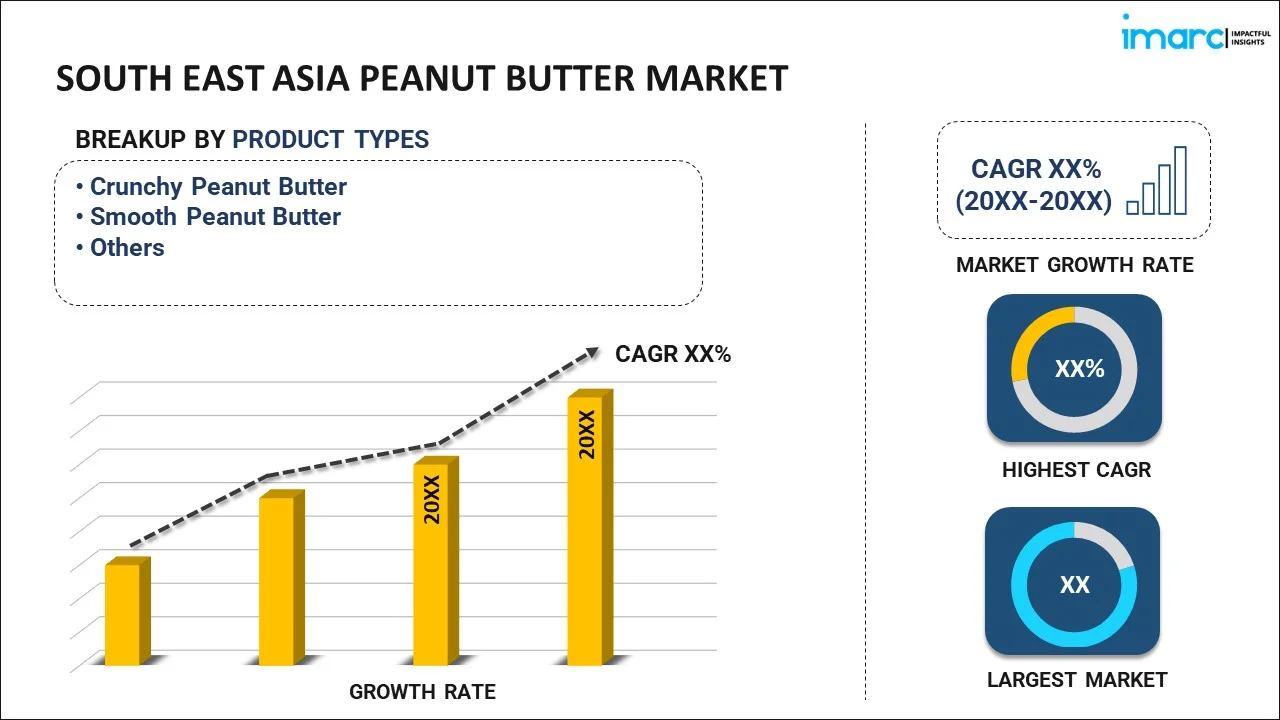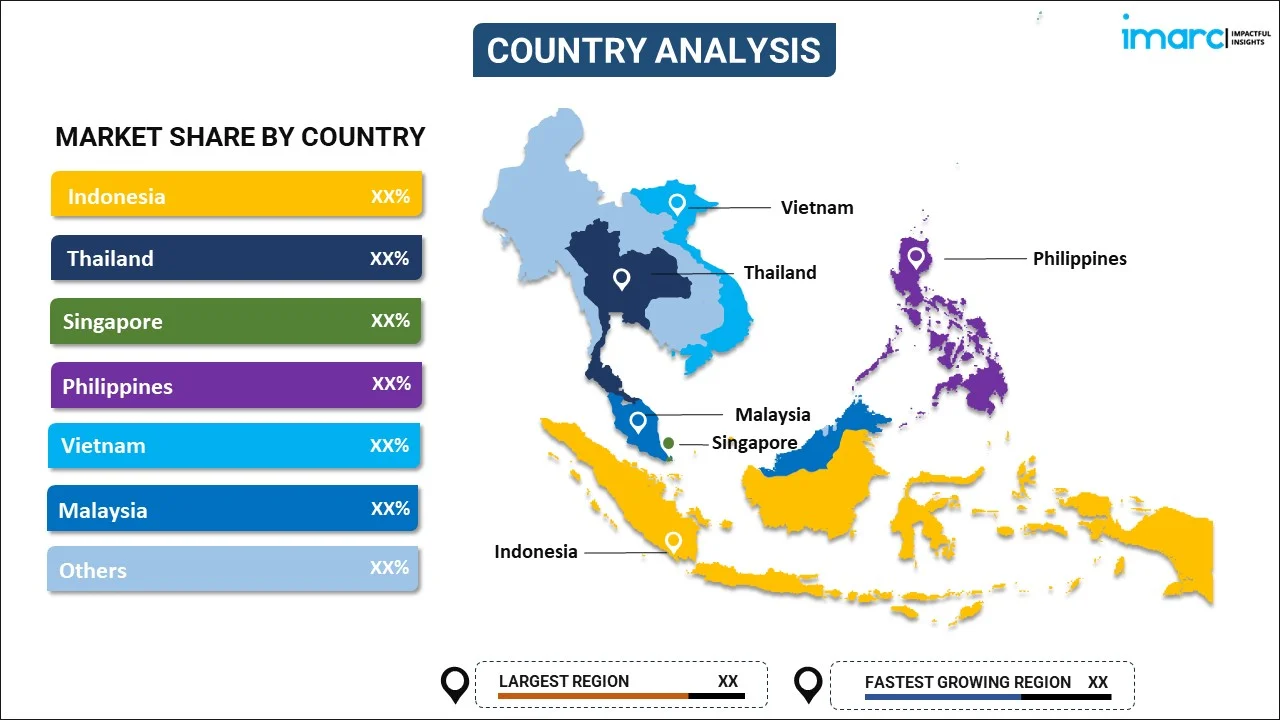
South East Asia Peanut Butter Market Report by Product Type (Crunchy Peanut Butter, Smooth Peanut Butter, and Others), Distribution Channel (Supermarkets and Hypermarkets, Convenience Stores, Online Stores, and Others), and Country 2024-2032
Market Overview:
South East Asia peanut butter market size is projected to exhibit a growth rate (CAGR) of 5.40% during 2024-2032. The increasing prevalence of effective marketing strategies, including advertising campaigns that highlight the versatility, nutritional benefits, and usage of peanut butter in various recipes, is driving the market.
|
Report Attribute
|
Key Statistics
|
|---|---|
|
Base Year
|
2023 |
|
Forecast Years
|
2024-2032 |
|
Historical Years
|
2018-2023
|
| Market Growth Rate (2024-2032) | 5.40% |
Peanut butter is a popular and versatile food product made primarily from ground, dry-roasted peanuts. Widely appreciated for its creamy texture and rich, nutty flavor, peanut butter is enjoyed as a spread, a dip, or an ingredient in various recipes. It is a significant source of plant-based protein, healthy fats, and essential nutrients, including vitamin E, magnesium, and potassium. The process of making peanut butter involves grinding roasted peanuts into a smooth paste, often with the addition of salt, sweeteners, or stabilizers, depending on the desired taste and texture. While traditional peanut butter is made solely from peanuts, variations such as chunky peanut butter incorporate small chunks of peanuts for added texture. This beloved food item has gained popularity, finding its way into sandwiches, baked goods, smoothies, and savory dishes, appealing to a diverse range of taste preferences and culinary applications.
South East Asia Peanut Butter Market Trends:
The peanut butter market in South East Asia has experienced robust growth in recent years, primarily driven by several key factors. Firstly, the increasing health consciousness among consumers has propelled the demand for natural and organic peanut butter variants. Consequently, this shift in consumer preference has prompted manufacturers to introduce healthier alternatives, thereby expanding the product portfolio and stimulating market growth. Moreover, the rising popularity of plant-based diets and the growing awareness of the nutritional benefits associated with peanut butter consumption have further amplified market demand. As a result, manufacturers are investing heavily in R&D to enhance product quality and develop innovative flavors, catering to evolving consumer preferences. Additionally, the proliferation of e-commerce platforms has significantly facilitated product accessibility, enabling manufacturers to reach a wider consumer base and capitalize on the growing online shopping trend. This enhanced accessibility, coupled with aggressive marketing strategies and promotional activities, has significantly boosted the visibility of peanut butter products, driving market expansion regionally. Furthermore, the surging demand for convenient and on-the-go snack options, coupled with the versatile application of peanut butter in various culinary preparations, is expected to drive the peanut butter market in South East Asia during the forecast period.
South East Asia Peanut Butter Market Segmentation:
IMARC Group provides an analysis of the key trends in each segment of the market, along with forecasts at the regional and country levels for 2024-2032. Our report has categorized the market based on product type and distribution channel.
Product Type Insights:

- Crunchy Peanut Butter
- Smooth Peanut Butter
- Others
The report has provided a detailed breakup and analysis of the market based on the product type. This includes crunchy peanut butter, smooth peanut butter, and others.
Distribution Channel Insights:
- Supermarkets and Hypermarkets
- Convenience Stores
- Online Stores
- Others
A detailed breakup and analysis of the market based on the distribution channel have also been provided in the report. This includes supermarkets and hypermarkets, convenience stores, online stores, and others.
Country Insights:

- Indonesia
- Thailand
- Singapore
- Philippines
- Vietnam
- Malaysia
- Others
The report has also provided a comprehensive analysis of all the major regional markets, which include Indonesia, Thailand, Singapore, Philippines, Vietnam, Malaysia, and Others.
Competitive Landscape:
The market research report has also provided a comprehensive analysis of the competitive landscape in the market. Competitive analysis such as market structure, key player positioning, top winning strategies, competitive dashboard, and company evaluation quadrant has been covered in the report. Also, detailed profiles of all major companies have been provided.
South East Asia Peanut Butter Market Report Coverage:
| Report Features | Details |
|---|---|
| Base Year of the Analysis | 2023 |
| Historical Period | 2018-2023 |
| Forecast Period | 2024-2032 |
| Units | US$ Billion |
| Scope of the Report | Exploration of Historical Trends and Market Outlook, Industry Catalysts and Challenges, Segment-Wise Historical and Future Market Assessment:
|
| Product Types Covered | Crunchy Peanut Butter, Smooth Peanut Butter, Others |
| Distribution Channels Covered | Supermarkets and Hypermarkets, Convenience Stores, Online Stores, Others |
| Countries Covered | Indonesia, Thailand, Singapore, Philippines, Vietnam, Malaysia, Others |
| Customization Scope | 10% Free Customization |
| Report Price and Purchase Option | Single User License: US$ 3699 Five User License: US$ 4699 Corporate License: US$ 5699 |
| Post-Sale Analyst Support | 10-12 Weeks |
| Delivery Format | PDF and Excel through Email (We can also provide the editable version of the report in PPT/Word format on special request) |
Key Questions Answered in This Report:
- How has the South East Asia peanut butter market performed so far and how will it perform in the coming years?
- What has been the impact of COVID-19 on the South East Asia peanut butter market?
- What is the breakup of the South East Asia peanut butter market on the basis of product type?
- What is the breakup of the South East Asia peanut butter market on the basis of distribution channel?
- What are the various stages in the value chain of the South East Asia peanut butter market?
- What are the key driving factors and challenges in the South East Asia peanut butter?
- What is the structure of the South East Asia peanut butter market and who are the key players?
- What is the degree of competition in the South East Asia peanut butter market?
Key Benefits for Stakeholders:
- IMARC’s industry report offers a comprehensive quantitative analysis of various market segments, historical and current market trends, market forecasts, and dynamics of the South East Asia peanut butter market from 2018-2032.
- The research report provides the latest information on the market drivers, challenges, and opportunities in the South East Asia peanut butter market.
- Porter's five forces analysis assist stakeholders in assessing the impact of new entrants, competitive rivalry, supplier power, buyer power, and the threat of substitution. It helps stakeholders to analyze the level of competition within the South East Asia peanut butter industry and its attractiveness.
- Competitive landscape allows stakeholders to understand their competitive environment and provides an insight into the current positions of key players in the market.
Need more help?
- Speak to our experienced analysts for insights on the current market scenarios.
- Include additional segments and countries to customize the report as per your requirement.
- Gain an unparalleled competitive advantage in your domain by understanding how to utilize the report and positively impacting your operations and revenue.
- For further assistance, please connect with our analysts.

 Inquire Before Buying
Inquire Before Buying
 Speak to an Analyst
Speak to an Analyst
 Request Brochure
Request Brochure
 Request Customization
Request Customization



.webp)




.webp)












